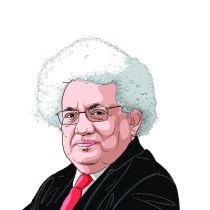Out of My Mind: IOU, RITA, TINA
In Malaga, there was a conference where they discussed topics such as the Index of Opposition Unity (IOU). Don’t believe There is No Alternative (TINA) because lo and behold, Rahul Is The Alternative (RITA).

The idea of a powerful coalition of opposition parties to topple the incumbent Ruling Party has haunted Indian politics since 1967, when Indira Gandhi faced her first general elections and Ram Manohar Lohia preached anti-Congressism.
The summer is hot in London and half of political India is in town. The only topic of conversation at posh dinners is the next Election. In Malaga, there was a conference where they discussed topics such as the Index of Opposition Unity (IOU). Don’t believe There is No Alternative (TINA) because lo and behold, Rahul Is The Alternative (RITA).
Chance would be a fine thing. The idea of a powerful coalition of opposition parties to topple the incumbent Ruling Party has haunted Indian politics since 1967, when Indira Gandhi faced her first general elections and Ram Manohar Lohia preached anti-Congressism as a strategy for opposition parties. It worked in the states but not at the Centre. In 1977 it did when the Emergency ended but in the event Janata coalition failed miserably to govern.
Thanks to Rajiv Gandhi, the Congress lost its hegemonic majority in 1989, never to regain it. Had he formed a coalition government then, he could have saved the Congress from steady irreversible decline. It took the Congress until Sonia Gandhibecame leader 10 years later to admit its weakness and embrace coalition government. The BJP tasted the fruits of coalition in 1998 and 1999. The surprise defeat of the NDA in 2004 gave the Congress a new life. In 2008, the Left formed a coalition to oppose Manmohan Singh’s nuclear policy and was defeated, never again to matter as a political force. In 2014, Narendra Modi changed history by winning a single-party majority for the BJP within the NDA.
So where the Congress was in 1967, the BJP is in 2019. There is no Lohia to argue for anti-BJPism, but being anti-Modi is the ideology. The idea of Mamata Banerjee is to have bilateral contests by pitting only one candidate from the Opposition against a BJP candidate. So far so good. But which party will field the candidate? Expect this issue to be a disruptor. The Congress would like to be the lead party with maximum candidates. But the rest are regional parties. In their region, each will want to exclude the Congress. West Bengal, Andhra Pradesh, Telangana, Tamil Nadu, Odisha, Uttar Pradesh (except for two family seats) are out of reach for the Congress. Even Bihar will be difficult as the RJD would want all the seats. There are, surprisingly, no regional parties in Gujarat, Rajasthan and Madhya Pradesh and so it will be the Congress versus the BJP. The Shiv Sena and NCP will snap off seats in Maharashtra from the Congress and AAP may meddle in Punjab and Haryana.
The target for the Congress would be to get to three figures, a net gain of at least 60 seats if it is to lead the coalition and propose Rahul Gandhi as PM candidate. But at that point, Mamata Banerjee, Chandrababu Naidu and Sharad Pawar may leave the coalition. Each believes s/he is more senior to Rahul and should be prime minister. They would take away 70-plus seats between them.
Whatever the uncertainty, there is no doubt that the BJP would be the singlelargest party, winning one-and-a-half times or twice as many seats as the Congress. If it crosses 220, other parties would abandon their pre-election coalition and rush to join the NDA. The IOU will be lower post-election than it would be pre-election. Thus RITA may be defeated by TINA.
For all the latest Opinion News, download Indian Express App
More From Meghnad Desai
- Out of my mind: Cross dressingThe Opposition has the one-item agenda of hating Modi. As in 1971, when the cry of the Old Congress was ‘Indira Hatao’, now it is…
- Groundhog stateA referendum in the Indian part of J&K should ask the people a simple question: Do you wish to stay in India or not?..
- Avoid ideologyNarendra Modi devised an inclusive strategy in 2014. He reached out to the Dalit voters. He downplayed anti-Muslim sentiments. He modernised the BJP by remaking…







































No hay comentarios:
Publicar un comentario